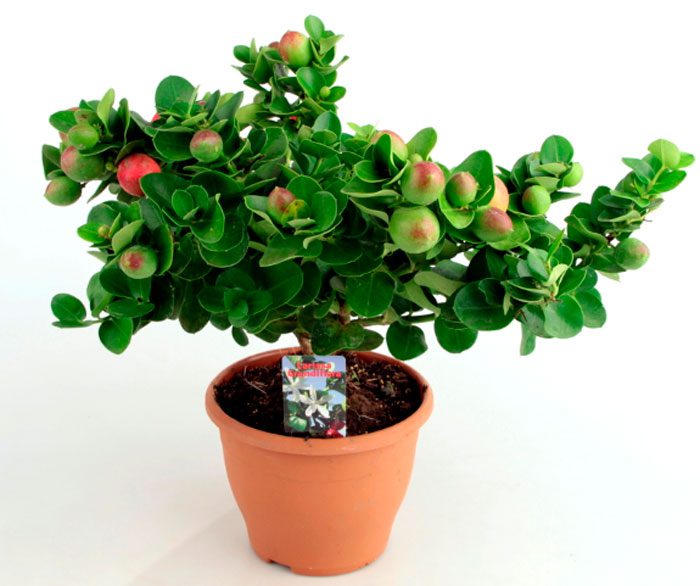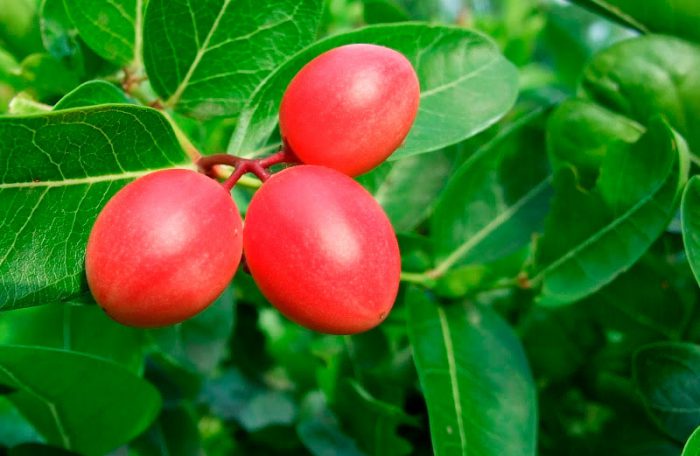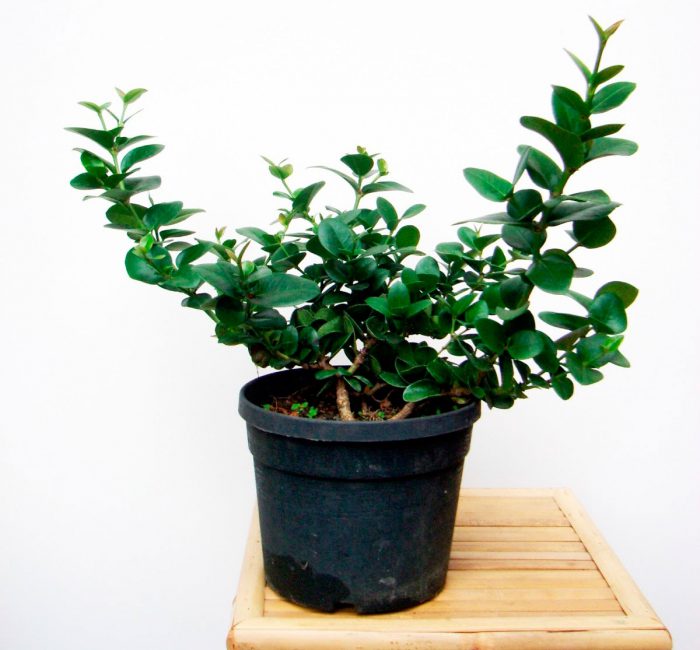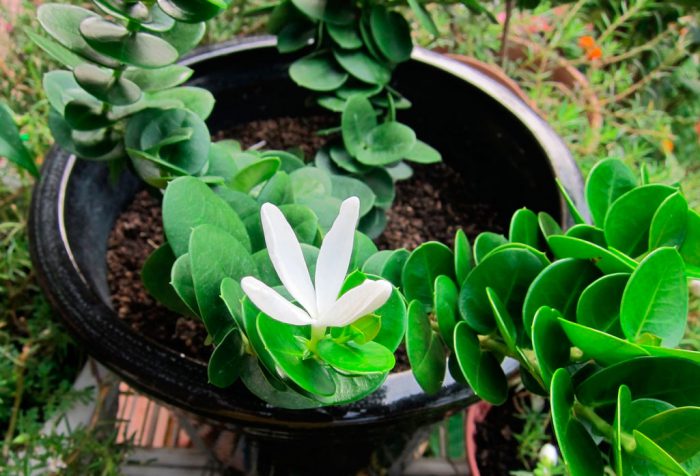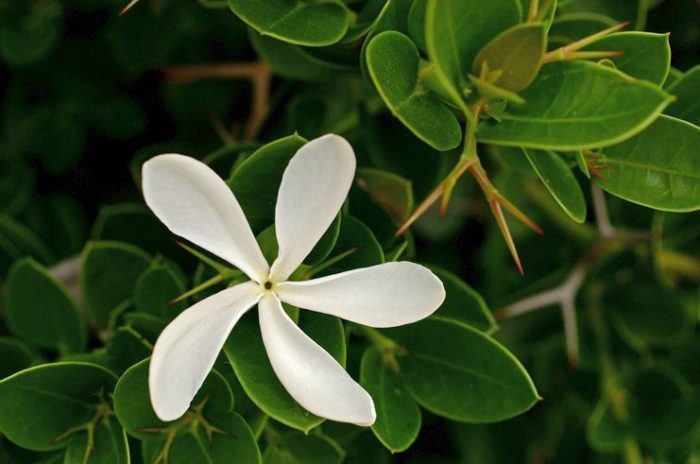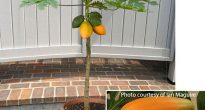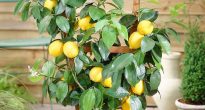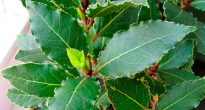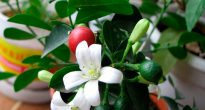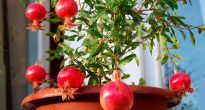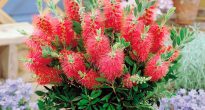Genus carissa (Carissa) is directly related to the Apocynaceae family. This genus unites about 35 species of plants, which are represented by small strongly branching shrubs and trees. In nature, they can be found in the subtropical and tropical forests of Africa, Hong Kong and Australia.
On the branches of this genus of plants there are protective two-toothed thorns, which are quite thick. There are species with very long spines (up to 5 centimeters). Opposite leathery leaves have rather short petioles. Simple oval leaves can be 3 to 8 centimeters long. The leaf blade is slightly folded along the central vein. The leaves themselves are deep, dark green in color, and the veins are painted in a pale green color. Young shoots are also painted in a pale green color.
The plant blooms for a very long time, or rather, almost the whole year. Tubular, simple flowers have 5 petals. They can be colored pink or white, and flowers grow in the leaf axils at the tips of the stems. Flowers can be collected in low-flowered inflorescences or be solitary. Outwardly, they have a clear resemblance to sambac jasmine flowers, and differ only in a less strong aroma. The flower can reach 1-5 centimeters in diameter.
At the end of flowering, in place of the flowers, fruits appear not very large in size, which are outwardly similar to a plum. The size of such fruits is directly dependent on the type of plant. So their size varies from 1.5 to 6 centimeters. At first, the fruit is colored red, but over time, its color changes to black or dark purple. These fruits can be eaten, and they have excellent taste. The pulp, which has a strawberry flavor, is very tender and juicy. Karissa is cultivated like a fruit tree, grown in gardens.
Thanks to breeders, a large number of varieties of carissa were born, but at the same time they focused on fruiting. The Fancy variety, like the Torrey Pines, bears abundant fruit and has very large fruits. The Gifford variety is one of the most productive.
Also, breeders tried to develop varieties that would be highly branching and had a relatively small size. These varieties are great for creating green sculptures and hedges. The resulting shrubs bear very little fruit, but do not have very large thorns. The most popular variety is "Grandiflora", as it is small and blooms quite abundantly. This variety is most often chosen for growing indoors, since this very spectacular plant is not capricious and undemanding to care for.
Content
Carissa care at home
Illumination
Bright illumination is required (approximately 6000–7800 lux). This plant feels great in direct sunlight, and therefore it is recommended to choose a south-facing window for its location. Carissa will feel quite good on the western or eastern window. When placed on a north-facing window, the plant will not get enough light to grow normally and will not bloom. Although it can grow here too, its stems will be quite elongated.
Temperature regime
In summer, it is recommended to keep the carissa at moderate temperatures from 18 to 25 degrees. In winter, it is best to transfer it to a cooler place (from 14 to 18 degrees), with this content in summer, flowering will be more abundant. However, if there is good backlighting to replace direct sunlight, flowering and fruiting will continue throughout the year.
It is quite resistant to sudden changes in temperature and has increased frost resistance (it can withstand a short-term drop in air temperature to 3 degrees). It is recommended to take Karissa out into the fresh air during the warm season, while she can stay there for quite a long time. And on a glazed loggia, a tree can be grown from March to October.
How to water
Watering should be done sparingly, but regularly. This plant is drought tolerant and can withstand almost complete drying out of the soil. Overfilling is quite dangerous for him, as it can lead to acidification of the substrate and rotting of the root system. As a rule, watering is carried out only after the top layer of the soil dries well.
It is necessary to water the carissa with exceptionally soft water, which has settled for at least 24 hours.
Humidity
It does not need high air humidity and feels quite comfortable even in winter, when the air in the apartments is very dry. In order to improve the appearance of the tree, as well as for hygienic purposes, he needs to regularly arrange a warm shower.
Pruning
Karissa needs a systematic pruning of shoots, which is designed to form the crown. But the task of flower growers in this case is complicated by the fact that this plant branches heavily, and its stems grow most often in all directions, therefore it is very difficult to form a neat crown. In no case should be pruning at all. It is a fast growing plant and after a short period of time it grows very strongly. And since there are rather sharp thorns on the shoots, this can cause a number of inconveniences.
Earth mix
There are no special requirements for the soil, but it is better if it is slightly alkaline. Feels great on both humus and sandy soil. Calmly tolerates salinity. It is quite simple to make a suitable soil mixture at home. To do this, it is necessary to combine leaf, peat, turf and humus soil, as well as sand in equal shares.
Don't forget to have a good drainage layer to prevent stagnation of liquid in the soil.
Fertilizer
In the event that flowering and fruiting continues throughout the year, then fertilization should be applied to the soil systematically, as a rule, once every 2 or 3 weeks. For this, mineral fertilizers are excellently suited, which contain a large amount of phosphorus, which the plant needs for long flowering. And on the contrary, fertilizing with nitrogen fertilizers is undesirable, because they provoke intensive foliage growth. So that the plant does not have chlorosis, it is necessary for preventive purposes to systematically introduce iron chelates into the ground. So, for example, this can be done while watering.
Transplant features
While the plant is young, it is transplanted in the spring every year. Older specimens are subjected to this procedure less often, or rather, once every 2 or 3 years. If the carissa is not transplanted for a long time, then its leaves will be noticeably crushed, and it will grow much slower.
Pollination
If at home you want to get fruits from this plant, then you will need to carry out artificial pollination of flowers.
Reproduction methods
For reproduction, seeds are used, as well as cuttings. Seed germination occurs very quickly, about half a month after sowing. However, seedling growth is rather slow. Such a plant begins to bloom in the second year.
The apical shoots should be cut for cuttings. They should be small and have 3 internodes. Rooting takes a long time, usually over 8-12 weeks. A successfully rooted stalk blooms in the same year. Cuttings are best rooted in a mini-greenhouse filled with a mixture of perlite and peat. Roots appear very rarely in the water.
Diseases and pests
It is quite resistant to various diseases. Root rot is most often formed, which is caused by overflow.
Can settle thrips, spider mite and shield... If pests are found, it is necessary to thoroughly rinse the carissa under a warm shower, and then treat it with specially designed chemicals.
How to use
Indoor carissa fruits taste the same as those harvested in the garden. And from them you can make mashed potatoes, fruit salads, jellies, and much more.
Attention! All parts of the carissa, with the exception of the fruit, contain poisonous substances. They are also present in unripe fruits, so if you eat them, you can get poisoned.

